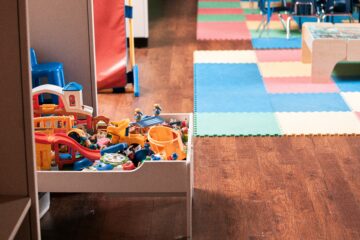Finding a happy medium between their children’s screen time and other types of play may be a real challenge for parents in this digital age. Screen time has grown in importance in many children’s lives due to the widespread availability of cellphones, tablets, and television. Equally crucial, though, are interactive toys that promote movement, imagination, and communication with others. Hey there, fam! Today, I’m diving deep into the world of screen time and interactive toys.
Get ready to discover all the amazing benefits and potential drawbacks they bring to your child’s development. Plus, I’ll be sharing some super helpful tips on how to find that perfect balance for your little one. So, let’s get started and unlock the secrets to raising a happy and healthy child in this digital age! To help you find a happy medium for your child’s growth and development, this article weighs the pros and cons of screen time and interactive toys.
Benefits of Screentime for Children
Screen time, when used correctly, can offer various educational and developmental benefits:
- Many applications, programmes, and games are intended to educate children by engaging them in subjects like as arithmetic, reading, and science. Khan Academy Kids, PBS Kids, and instructional YouTube channels can all be effective learning aids.
- Certain video games and applications can help with cognitive skills including problem solving, hand-eye coordination, and spatial awareness. Games that require strategic thought and quick reflexes can help strengthen these abilities.
- Screen time can give much-needed rest and amusement. It can help children unwind after a long day at school or extracurricular activities.
- Platforms such as Zoom, Skype, and other video calling apps enable children to maintain contact with friends and family, which can be especially useful during times of physical estrangement or isolation.
Downsides of Spending Too Much Time on Screens
While there are definitely some advantages to spending time in front of screens, it’s important to be aware of the potential downsides:
- Less Physical Activity: Spending too much time in front of screens can lead to a sedentary lifestyle, which may increase the risk of obesity and other health problems in children.
- Screen time, especially before bed, can mess with your sleep patterns because of the blue light that screens emit. This light messes with the production of melatonin, which can make it harder for you to fall asleep.
- Spending too much time on screens can kind of limit your chances to interact with people in person. And you know what? Those face-to-face interactions are super important for developing your children’s social skills and emotional intelligence.
- Being exposed to a lot of fast-paced digital content can sometimes make it a bit trickier for kids to focus and pay attention. This might make it a little more challenging for them to really get into activities that require them to concentrate for a while.
Benefits of Interactive Toys
Interactive toys, which include everything from building blocks to dolls to board games, offer numerous developmental advantages:
- Many interactive toys encourage movement and physical activity. For example, playing with a ball, riding a bike, or engaging with toys that require manual manipulation can help develop motor skills and promote physical health.
- Toys like LEGO sets, action figures, and arts and crafts kits stimulate creativity and imaginative play. These activities allow children to invent stories, solve problems, and explore different scenarios.
- Interactive toys often involve cooperative play, teaching children important social skills such as sharing, turn-taking, and communication. Board games and team sports are excellent examples of toys that promote social interaction.
- Puzzles, building sets, and educational toys challenge children to think critically and solve problems. These activities support cognitive development and enhance skills like spatial reasoning and logical thinking.
Challenges of Interactive Toys
While interactive toys offer many benefits, they are not without challenges:
High-quality interactive toys can be expensive, and keeping up with the latest trends or replacing worn-out toys can be a financial burden.
Physical toys require storage space, which can be limited in small living environments.
Some interactive toys, particularly those that involve small
Finding the Balance
Balancing screen time and interactive play is essential for fostering well-rounded development in children. Here are some strategies to help achieve a healthy balance:
Set Clear Limits on Screen Time
For children aged 2 to 5 years: Limit screen use to one hour per day of high-quality programming.
For children aged 6 years and older: Place consistent limits on the amount of screen time, ensuring it does not interfere with sleep, physical activity, and other essential behaviors.
Use parental control settings on devices to enforce these limits and create screen-free zones or times, such as during meals and before bedtime.pieces or messy activities, require adult supervision and cleanup, which can be time-consuming for busy parents.
Keep an eye on things and make any necessary changes.
Make sure to keep an eye on how much time your child spends on screens and what kind of activities they engage in. Keep an eye on how they’re doing, both in terms of their behaviour, academics, and overall happiness. Make sure to find the right balance so that screen time stays helpful and doesn’t take over other important activities.
Encourage a culture of open communication
Have a chat with your kid about how it’s good to mix up different kinds of play. Feel free to ask them about their thoughts and preferences, and get them involved in deciding on screen time rules and choosing interactive toys. Having open communication is important because it helps children develop a sense of responsibility and gain a better understanding of why rules are in place.
In summary
It’s important to strike a good balance between screen time and interactive play for your child’s healthy development. Using screens can be pretty cool. They can teach your kids a lot of stuff stuff and keep them entertained. But it’s also important to not overdo it and make sure you’re doing other fun activities that help them grow physically, socially, and mentally. Parents can create a balanced play environment that supports their child’s overall well-being by setting clear limits, modelling healthy behaviour, and fostering open communication.
Hey, if you liked this article, make sure to check out our other articles on child development, educational strategies, and tips for creating a fun and stimulating play environment for your kids. We’re all about helping parents and carers with useful insights and practical advice on our website.



0 Comments